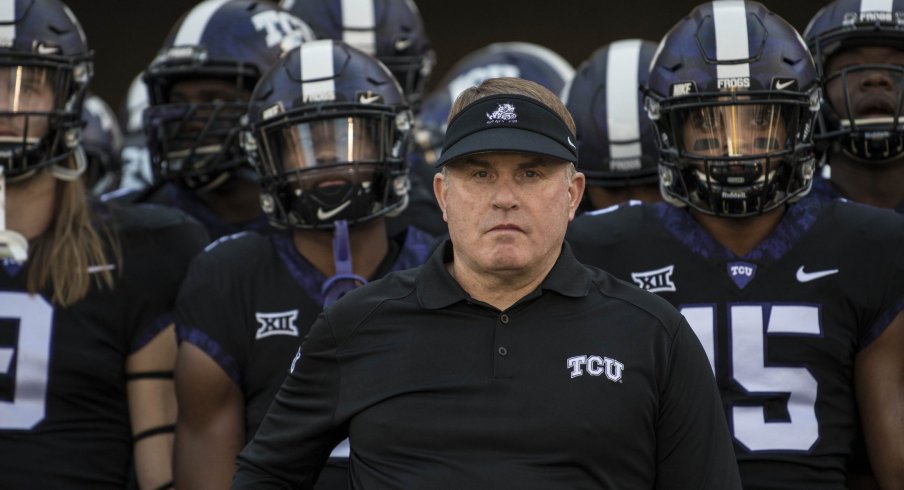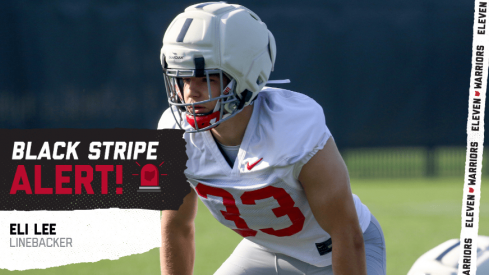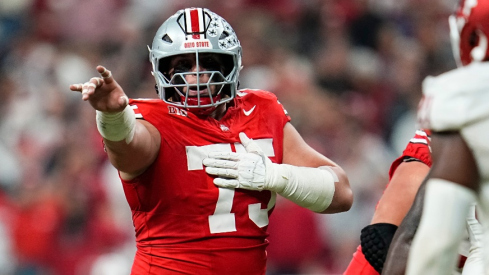With less than two months remaining until the 2018 season kicks off, it's no longer premature to spend summer days looking ahead to the fall.
While Ohio State is expected to play a big role in the national title picture yet again, this year's schedule contains a number of new and unique challenges. Some of the names below may be expected while others may be a surprise, but this is not a list of the Buckeyes’ biggest challenges overall, given their advantage in overall talent.
As the Iowa game showed last year, however, showing up unprepared can quickly negate that edge. Here are the five biggest tests Ohio State will have to pass in the press box as well as on the field in 2018:
5) Maryland offense
Despite the manner in which he parted ways with Ed Orgeron after only one season at LSU, new Maryland coordinator Matt Canada remains one of the most interesting offensive minds in the nation. Canada, who shaped the University of Pittsburgh’s offense into a top ten scoring unit in 2016 before joining the Tigers last year, is not known for a specific playbook or style, and instead is known to fit his system to the players available.
However, he typically leans heavily on gap-blocked runs like Power-O, Counter-Trey, and Buck Sweep that can take awhile to develop and see multiple pullers lead the way for the runner. Additionally, he includes a number of RPOs and changes in tempo to keep defenses off balance, despite often lining up under center with multiple tight ends.
But what sets him apart is the manner in which he uses pre-snap motion and shifts to keep the defense constantly forcing to adapt in kind, often leading to an eventual mistake.
The Tigers initially struggled to execute the system last fall, leading Orgeron to strip away many of the pre-snap movements that disguised the offense's intentions and ultimately led to Canada's departure.
While the Buckeyes will have plenty of tape to review by the time they take on Canada's latest iteration on November 17th, Greg Schiano's defense will still have to be ready for all the Jet Sweeps, H & Y trades, and unbalanced lines likely to come their way that afternoon in College Park.
4) Nebraska offense
Scott Frost may finally make the Big Ten West fun. Unlike most of his peers in the division opposite that of OSU, the new Nebraska head coach is not intent on lining up in the I-formation and slowly bleeding opponents to death.
Rather, the former Husker option QB and Chip Kelly protege is bringing his pace-and-space offense to the heartland, looking to replicate the same system that saw his undefeated UCF squad become not only the nation's leader in scoring but finished second in yards-per-play last fall.
While many of the concepts presented will look familiar to the Buckeyes' own, given Ryan Day's connection to Kelly, the manner in which they're packaged is quite different. Frost is known to combine the best parts of the classic spread movement (uptempo option reads based out of three and four-receiver sets) with pro-style isolations that create individual personnel mismatches in favor of the offense.
For example, in the example below, the offense is running a variation of the Saints concept we've seen many times from the Buckeyes. However, to get the Z receiver open over the middle for a big gain, Frost motions him across the formation before going under the tight end to create the middle vertical stretch. With the corner matched up with him expected to maintain outside leverage as the last man to one side, the receiver has an advantage to the inside before the ball is ever snapped.
Plenty of questions remain about the current roster in Lincoln, and whether or not Nebraska already has the players to fit this system. Like Canada, though, Frost employs a great deal of pre-snap movement to force defenders into mental paralysis. This, along with the new style of option football that's quite different from the one the Huskers' new coach ran for Tom Osborne 20 years ago will make Ohio State's November 3rd tilt with Big Red quite a challenge.
3) Purdue offense
While Canada may be a master of disguise and Frost may push the limits of Spread-Option football as we know it, Purdue head coach Jeff Brohm may hold the title as the Big Ten's most creative schemer. Honestly, how many other guys have a reverse flea-flicker in the playbook?
Boiler up to somethin pic.twitter.com/9nOctDbgXW
— FOX College Football (@CFBONFOX) September 9, 2017
But the Boilermakers' head man has plenty of substance to go along with that style. Based out of Bobby Petrino's version of the one-back passing game, Brohm's offense requires precision to execute properly, much like the countless professional playbooks Petrino has influenced over the years.
Receivers rarely execute simple routes, often switching with one another to create natural picks on a defender to create space in addition to running excellent routes. Unlike many college offenses in the modern game, though, the tight ends and running backs play a big part in the passing game, stressing linebackers and safeties in a way few are used to.
As detailed HERE by SBNation's Ian Boyd, Brohm turned a simply four-verticals concept into a work of art, releasing the back to occupy the middle linebacker long enough to create a window for the tight end over the middle.
/cdn.vox-cdn.com/uploads/chorus_asset/file/9282051/Purdue_4_verts.gif)
While the Boilers may have struggled against good teams in Brohm's first year in West Lafayette, tallying only 189 yards against Michigan and 221 against Wisconsin, there is reason for optimism from a passing game that eclipsed 250 yards six times in 2017 despite rotating between two quarterbacks, both of whom return this fall. Now with another year to fix the problems with what was long one of the conference's worst offensive lines, the Boilermakers are expected to make similar strides forward on the ground.
While not known to be one of the most hostile environments in the nation, Ross-Ade stadium has been the site of far more losses than Buckeye fans would like. When OSU returns October 20th for the first time since 2013, Brohm will undoubtedly have plenty of new wrinkles awaiting them.
2) Michigan defense
Seeing Don Brown this high on the list should be no surprise to anyone. The man keeping Jim Harbaugh employed in Ann Arbor could have his most talented bunch yet this fall with, stars like Rashan Gary, Chase Winovich, Devin Bush Jr., and Khaleke Hudson all vying for All-American status.
But as you'd expect from one of Brown's defenses, they won't just line up the same way every play and dare offenses to beat them. With multiple fronts, coverages, and blitzes, Brown's playbook is as deep as anyone's - Nick Saban included. But while Saban and his acolytes like to match every single look with the perfect coverage, Brown solves his problems with aggression.
These blitzes can come from anywhere: corners on the edge, linebackers through the middle, or safeties in the alleys. Instead of blitzing one way all the time, Brown constantly keeps offenses guessing. He's able to get away with this because of the excellent man-coverage ability of everyone in his secondary, many of whom have already shut down #Zone6 on more than one occasion.
But as the past two years have shown, the difference between Urban Meyer's option run game and Brown's aggressive fronts has been the subtle chess moves employed by either side that the other did not expect. For instance, Ohio State never showed this play in 2017 before The Game:
But the shift from J.T. Barrett to Dwayne Haskins at quarterback throws a new wrinkle into this mix, as Brown will have a season's worth of tape on the sophomore this time around. Will what the Buckeyes choose to keep hidden in the playbook until November 24th be worth waiting for?
1) TCU defense
Before this becomes a thread on this (or any other) site, let's just be clear: TCU's defense probably isn't better than the one listed above, but given the lack of familiarity with Gary Patterson's 4-2-5 Robber system, it's the biggest schematic puzzle the Buckeyes should have to solve this fall. As the inspiration for the USC scheme seen in last season's Cotton Bowl, the Buckeyes will hope to have a better showing in this trip to AT&T Stadium on September 15th.
Unlike Brown's approach of selling out with aggression, Patterson's defense gives the appearance of such an approach while still maintaining conservative integrity on the back end. The Horned Frogs were one of the first units to employ split-field coverage, defending each side differently based on a host of factors such as personnel, formation, or location on the hash marks.
As Chris B. Brown wrote of the 4-2-5 scheme back in 2015:
By playing five defensive backs, Patterson almost never needs to substitute to match up with the offense. But the system’s genius runs even deeper: Patterson has cleaved the very structure of his defense into pieces, simultaneously making everything simpler for his players and more complicated for opponents.
“We divide our defense into attack groups,” Patterson explained at a coaching clinic in 2011. Those attack groups are: (1) the four defensive linemen and two linebackers, referred to as the front, (2) one cornerback, the free safety, and the strong safety, and (3) the weak safety and other corner. For most teams, the calls for the front and secondary only work if appropriately paired, but that’s not the case for TCU. “Our fronts and coverages have nothing to do with each other,” Patterson said at the clinic. “The coverage part is separate from the front.”
But unlike many defensive play-callers that simply try to match what the offense is doing, Patterson tries to dictate the flow of the game, often blitzing on early down in hopes of creating a second-and-long that puts the offense behind schedule and forced to throw downfield. Once in that position, the quarterback can easily be confused by what he sees, as the defense may be playing a simple zone to one side of the field with a pattern-matching coverage to the other.
But Patterson's secret to success is that he doesn't just teach his defenders their own schemes, they pay closest attention to those of the opponent. As he detailed in a 2015 coaching clinic, “We teach our players to play the play. If they know what is coming, they will stop it for a loss," said Patterson. "In six games [in 2014], Ole Miss motioned down to the inside with a receiver, and every time they ran the same play, a sweep. When they ran [the motion], our linebackers knew it was going to be the sweep play toward the motion.”
As you might've guessed, TCU went on to hammer the Rebels 42-6 in the 2014 Peach Bowl, thanks in large part to Patterson's preparation. Knowing the Buckeyes will likely rely heavily on the ground attack of J.K. Dobbins and Mike Weber as Dwayne Haskins makes his first start outside of Ohio Stadium, the TCU head coach will likely try to employ the same philosophy in the matchup between the two preseason top-ten teams.
It's on Urban Meyer, Kevin Wilson, and Ryan Day to ensure he doesn't know what's coming.



